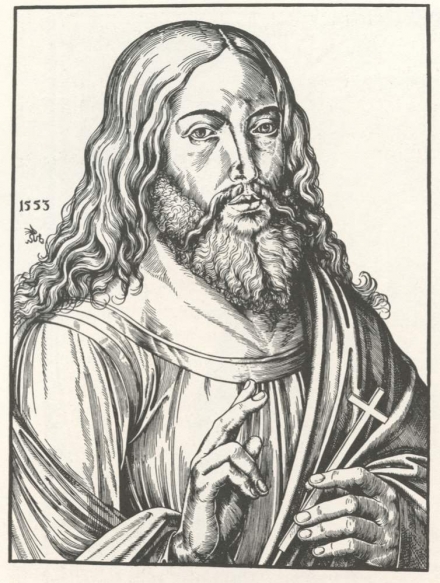Cranach’s Form of the Body of ...Jesus (1553)
In the mid-sixteenth century religious literalists who took the Bible as historical truth showed a great deal of interest in what Jesus actually looked like. Some cited the authenticity of his image in particular icons while others found it even in recent paintings which they thought to be old. Cranach produced this woodcut in 1553 accompanied by a text from a Byzantine preacher describing Jesus' physical appearance in detail. Joseph Koerner noted in 1993 that Cranach had actually based his woodcut......
Click next thumbnail to continue
......on a 1503 painting by Jacopo de' Barbari which Cranach happened to own. Koerner added that this painting had by 1553 come to be thought of as an accurate likeness of Christ, helped possibly by the seeming authenticity of the Hebrew lettering. It is even possible, he claims, that this painting is based on Durer's 1500 Self-Portrait resembling Christ.1 If so, Cranach knew that this Christ was based on an "artist", the great German artist, Dürer. Koerner misses this last point.
Click next thumbnail to continue

Left: Detail of Cranach's The Form of the Body of Our Lord Jesus
Right: Detail of Cranach the Younger's Portrait of Cranach the Elder (1550)
Click image to enlarge.
He also failed to see that Cranach's woodcut of Christ, even if based on Jacopo's painting, resembles Cranach himself. Perhaps Cranach purchased Jacopo's portrait because it resembled him or he later came to identify similarities which he was able to accentuate in the woodcut. Whichever way, Cranach executed the woodcut after Jacopo's painting not because it resembled the authentic body of Christ but himself.
See conclusion below
There is an irony here. While this image superficially seems to address the needs of Biblical literalists for an authentic image of Christ, Cranach really drew it as a Christian mystic who knows that by focussing inwards we can each find God inside our own self.
More Works by Cranach the Elder
Notes:
1. Koerner, The Moment of Self-Portraiture in German Renaissance Art (University of Chicago Press) 1993, pp. 116-8
Original Publication Date on EPPH: 18 Oct 2011. | Updated: 0. © Simon Abrahams. Articles on this site are the copyright of Simon Abrahams. To use copyrighted material in print or other media for purposes beyond 'fair use', you must obtain permission from the copyright owner. Websites may link to this page without permission (please do) but may not reproduce the material on their own site without crediting Simon Abrahams and EPPH.





